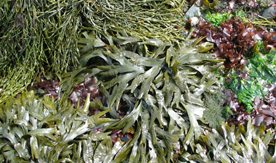
UMaine Collaborative Research Project Looks at Interactions Between Bacteria and Marine Algae
Understanding the biodiversity of bacteria associated with marine algae that contribute to marine ecosystem health is the focus of a study led by three University of Maine researchers.
Susan Brawley, a professor of plant biology in the School of Marine Sciences and a cooperating professor in the School of Biology and Ecology, is leading the three-year project. At UMaine, Brawley is working with John Singer, a professor of microbiology, and Benildo de los Reyes, a professor of biological sciences.
The three-year study is a collaborative research project with Hilary Morrison at the Marine Biological Laboratory (MBL) in Woods Hole, Massachusetts, and is funded by a more than $1.4 million grant from the National Science Foundation — $986,515 to UMaine and $480,016 to MBL.
“The macroalgal microbiome in space and time — maintaining primary producers in the Atlantic rocky intertidal zone,” will focus on interactions between microbes and intertidal macroalgae, and how their relationships change in response to natural and human-driven stresses.
Intertidal macroalgae, or seaweeds, provide shelter and food to many invertebrates and young fishes. Although much is known about how intertidal algae react to natural stresses, little is known about their associated bacteria and how these bacteria react to those stresses. Past studies found that some macroalgae disintegrate after bacteria are removed, suggesting the bacteria are essential to the algae’s health, according to the researchers.
The study will examine genetic, taxonomic and functional aspects of the biodiversity of bacteria associated with seaweeds that are important to the health of marine ecosystems. It will determine how the bacteria change depending on the season, position within the intertidal zone and latitudinal range, the researchers say.
The researchers say little is known about how macroalgal microbiomes change in space and time, and they hope the study will serve as an important trans-Atlantic baseline of the microbiomes’ biodiversity.
The project is one of 12 studies funded by NSF’s Dimensions of Biodiversity Program. A total of $23 million was invested with contributions from NSF’s Directorates for Biological Sciences and Geosciences, the Sao Paulo Research Foundation and the National Natural Science Foundation of China, according to the foundation.
The Dimensions of Biodiversity Program differs from traditional biodiversity research that focuses on one ecosystem by integrating multiple aspects into research projects and offering opportunities to make advances in understanding the generation, maintenance and loss of biodiversity, the NSF states.
“This year’s portfolio of projects will accelerate our understanding of biodiversity across disciplines and across scales of time and space,” Penny Firth, director of NSF’s Division of Environmental Biology, says in a press release. “Through this program, we’re witnessing a transformation in our ability to bridge scientific approaches and perspectives.”
The research will fill in gaps in biodiversity knowledge, Firth says. It also has the potential for significant effects on agriculture, fuel, manufacturing and health.
Contact: Elyse Kahl, 207.581.3747
